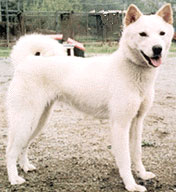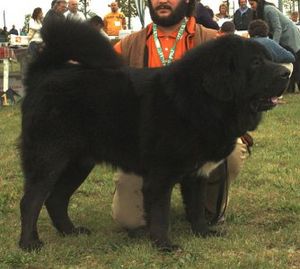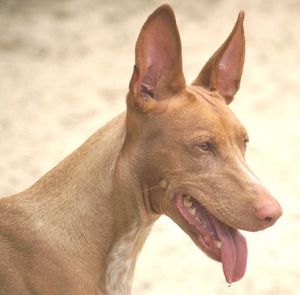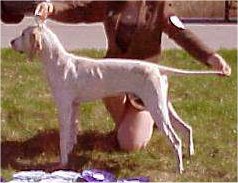 |
| Vital Statistics: |
| Place of Origin: Korea |
| Group: Working dog |
| Height: males 18-25 in., females 16-22 in. |
| Weight: males 35-50 lbs., females 25-40 lbs. |
| Life span: 12-15 yrs. |
| Trainability: moderate |
| Good with children: must be socialized early with them |
| Good with other pets: may be dog aggressive, high prey drive, may chase small animals |
- What is the origin of the Korean Jindo Dog?
The Korean Jindo Dog also called Chindo or Jindo Gae, has its origins on Jindo Island, Korea. This ancient dog was wild and survived on its own on the island. It is internationally protected under Natural Treasures. While exporting the Jindo is illegal, immigrants to the U.S. have brought their dogs with them.
- What does the Korean Jindo Dog look like?
Males are 18-25 inches tall and weight 35-50 lbs. Females are 16-22 inches tall and weigh 25-40 lbs. Jindos are spitz-like in appearance, medium size. Ears are erect. The plumed tail curls over the back. The dense coat is medium long. Coat colors are white, black, fawn, brindle or black and tan. These dogs clean themselves like cats, but still need occasional brushing.
- What is the temperament of the Korean Jindo Dog?
Jindos are highly intelligent and will often think independently. They need lots of attention and if they become lonely, can be quite destructive. They get along well with other dogs but may view small animals as prey. Jindos should have early training with a kind but firm hand. Early socialization is very important. Jindos are active dogs and require a good amount of exercise. Yards should be secure with a high fence that’s placed into the ground. Always walk a Jindo on a leash. If given enough exercise they adapt to apartment living.
- What is the Korean Jindo Dog used for?
Jindos are excellent hunter and have a high prey drive. They are able to bring down large prey like deer. They are excellent watchdogs and are very loyal to their family. This is a dog for someone willing to donate time to training and giving the dog lots of attention.
Possible Health Issues
Hip dysplasia, eye problems such as cataracts, thyroid issues.
- Akbash Dog
- Alaskan Malamute
- Anatolian Shepherd Dog
- Appenzell Mountain Dog
- Belgian Malinois
- Boxer
- Burnese Mountain Dog
- Canaan Dog
- Chinook
- Deutscher (German) Pinscher
- Doberman Pinscher
- Dogue de Bordeaux
- Estrela Mountain Dog
- German Spitz (Giant, Standard, Toy)
- Giant Schnauzer
- Great Dane
- Greater Swiss Mountain Dog
- Greenland
- Irish Red & White Setter
- Kai Ken
- Kuvasz
- Laika
- Leonberger
- Newfoundland
- Norwegian Elkhound
- Rat Terrier
- Rottweiler
- Saint Bernard
- Samoyed
- Siberian Husky
- Standard Schnauzer
- Tibetan Mastiff



